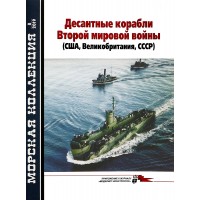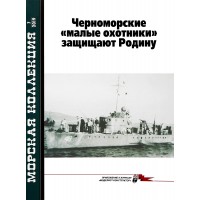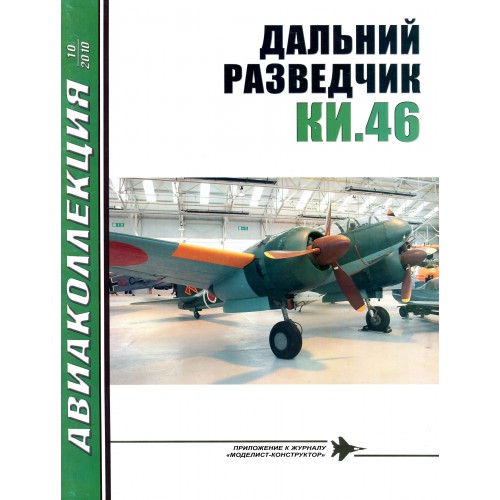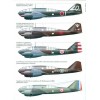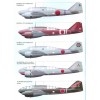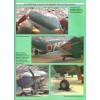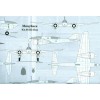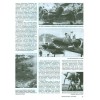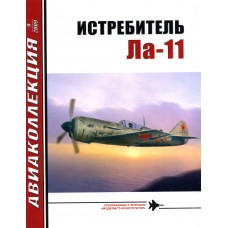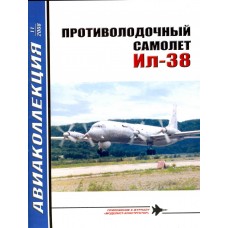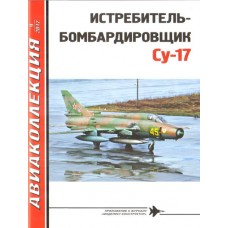AKL-201010 AviaCollection / AviaKollektsia 10/2010: Mitsubishi Ki-46 'Dinah' WW2 Twin-Engine Long-Range Reconnaissance Aircraft of Imperial Japanese Army. Photos, schemes, colour pictures. 32 pages, soft cover, text in Russian.
CREATING A PLANE
In the late 1930s the main type of long-range reconnaissance aircraft in the Japanese army was the Ki.15, a rather large single-engine three-seat monoplane, which was put into service in 1937. The same aircraft, with slight differences in equipment, was operated by naval aviation under the designation S5M. Despite the non-retractable landing gear, the vehicle had a good speed and successfully evaded interception by enemy fighters. But in those years, aviation progressed rapidly; what suited today did not fit tomorrow. During the battles on Khalkhin Gol in the summer of 1939, Ki.15 were already intercepted and shot down by Soviet fighters of the latest modifications.
All this was the reason that shortly after the start of the serial production of Ki.15, the Japanese began developing technical requirements for the next generation long-range reconnaissance aircraft. In the same 1937, in the Technical Directorate of the Imperial Army Air Force Headquarters, Major Fujita and engineers Ando and Tanaka began to study the development trends of aircraft for this purpose. The result was a new assignment, signed in late fall. The military needed a high-speed long-range reconnaissance officer capable of making secret flights over the territory of neighboring countries in peacetime.
The main condition of his invulnerability, the authors of the assignment considered speed. The plane was required to keep a cruising speed of 420 km / h for six hours at an altitude of 4000 - 6000 m; the maximum speed was determined at 600 km / h. For that time, these were extremely high requirements. The new Japanese reconnaissance aircraft could overtake fighters that had just entered service in England ("Hurricane") and the United States (P-36A).
Moreover, in both cases, the advantage was very significant - 80 - 90 km / h.
A sharp increase in speed was promised by the transition to a twin-engine monoplane with a fully retractable landing gear. The assignment listed three types of motors that could be installed on the plane: Kawasaki Ha. 20-0tsu (790 hp), Nakajima Ha. 25 (950 hp) and Mitsubishi Ha.26 (850 hp).
These were all air-cooled radial engines.
According to the compilers of the assignment, the scout did not need powerful defensive weapons at high speed. The plane was supposed to elude the fighters, and not fight them. Therefore, only one machine gun of type 89 of 7.7 mm caliber with an ammunition capacity of 216 (why they chose such a non-circular number remains a mystery) was provided for, located in the rear cockpit.
The Mitsubishi Jyukogyo company received the assignment for the new reconnaissance aircraft on December 12, 1937. The chief designer Tomio Kubo supervised the development of the vehicle. H. Kato, M. Mizuno and S. Sugiyama worked with him on the scout's project.
When designing a new machine, they used the experience of working on the Ki.39 twin-engine heavy fighter, which was brought only to the stage of a technical proposal. For him, an option with an increased radius of action was envisaged, called Ki.40. The general layout of this machine and a number of design solutions were used in the new reconnaissance aircraft, designated Ki.46.
Initially, Kubo did not agree with the list of recommended engines proposed by the military, believing that from an aerodynamic point of view it was more profitable to use liquid-cooled engines. But there were no powerful engines of this type in Japan at that time. I had to choose from among those offered. Kubo settled on the Xa.26 ("type 99") - with a two-row layout, it had the smallest outer diameter.
Taking into account the required high flight speeds, the designers paid great attention to aerodynamics. In this they were assisted by specialists from the Institute of Aeronautical Research at the University of Tokyo. There, in a wind tunnel, models of variants of the aircraft and its individual units were blown through. These studies led to the fact that the initially selected wing profile was replaced with a thinner one, and the fuselage and engine hoods were extremely compressed. The latter was dictated not only by the desire to achieve the lowest aerodynamic drag, but also by the requirement to provide the reconnaissance crew with a good view to the sides.
As a result, Kubo and his team designed a sleek and lightweight twin-engined all-metal cantilever monoplane. A thin trapezoidal wing had one main spar and two auxiliary ones. The fuselage of very clean outlines was made according to the semi-monocoque scheme, with an oval cross-section. The aircraft skin was load-bearing, smooth, with a secret K Lёpka. The single-fin tail unit included elevators and rudders sheathed in metal rather than covered in canvas.
In the forward fuselage there was a compartment where one of the cameras was located. Instead, an additional gas tank could be placed there. The scout's crew consisted of two people. The pilot sat at the leading edge of the wing, the radio operator at the rear. Each had its own cockpit under a separate canopy. The crew members' seats were divided by the main gas tank. Two more tanks were located in the wing.
A 7.7 mm type 89 machine gun with 216 rounds of ammunition was mounted in the rear cockpit. To bring it into a firing position, it was required to move one of the sections of the canopy forward. In the stowed position, the gun mount did not break the flow around the fuselage. The shooter also had the second camera.
The landing gear was completely retracted in flight. The main struts folded back into the engine nacelles and were completely covered with flaps, the tail wheel was laid back in the fuselage niche, which was flush with the skin with flaps.
Xa.26-1 14-cylinder twin-row radial engines (875 hp), located in well-streamlined nacelles, rotated three-blade metal propellers. Their sleeves were covered with large cocks.
Since the aircraft was not intended to be used as a light bomber, there was no bomb armament.
The production of the first prototype started or about a year after the start of design at the Mitsubishi plant in Gifu near Nagoya. It was ready at the end of November 1939. In the same month, it was transported to the Kagamigahara airfield and lifted into the air for the first time.
The scout was piloted by Major Yuozo Fujita. During the tests, the aircraft showed good flight data, but its speed did not exceed 540 km / h at an altitude of 4000 m.It turned out that the shortfall to the task requirements was 60 km / h, but at the same time the reconnaissance aircraft overtook new Japanese fighters. The Ki.43-1 army monoplane was inferior to the Ki.46 prototype by about 55 km / h, and the best of the best was the A6M2 carrier-based fighter, somewhere between 8-10 km / h.
Perhaps this is what led to the fact that the plane, and in this form, was adopted by the aviation of the imperial army as a "type 100", which roughly corresponds to our "model of 1940", only the Japanese chronology was used. More precisely, the aircraft was officially called "Strategic Reconnaissance Type 100 Model 1", but more often a short designation appeared in the documents - Ki.46-1.
But we must immediately mention that the designers of "Mitsubishi" did not achieve their goal. Ki.46 could easily get away from Japanese fighters, but in the West (in Germany and Great Britain) in 1940 there were already more advanced machines. Thus, the English "Spitfire" IIA was ahead of the Japanese reconnaissance aircraft by more than 50 km / h. The concept of invulnerability through speed has come under threat. Nevertheless, Ki.46-1 was put into production at the Gifu plant.
AKL-201010 AviaKollektsia N10 2010: Mitsubishi Ki-46 'Dinah' WW2 Twin-Engine Long-Range Reconnaissance Aircraft of Imperial Japanese Army magazine
- Brand: AviaCollection / AviaKollektsia
- Product Code: AKL-201010 In Stock
-
$3.90
Available Options
Look at these products too:
AKL-201709 AviaCollection 2017/9 Sukhoi Su-17 Russian Jet Fighter-Bomber Story
AKL-201709 AviaCollection N9 2017 Sukhoi Su-17 'Fitter' Russian Jet Fighter-Bomber Story. All about ..
$3.90



